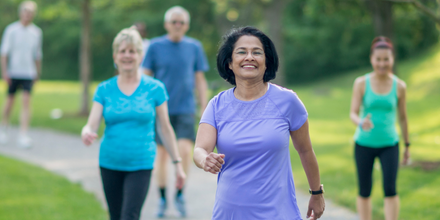Walking may be one of the easiest ways to get physically active and squeeze in exercise. Just get your shoes on and go! The Centers for Disease Control and Prevention recommends 150 minutes per week of moderate intensity physical activity. Walking is a great way to meet this recommendation, but what makes this form of activity so special?
Benefits of Walking
- Maintain a Healthy Weight — Walking is an aerobic activity that burns calories as you move. Finding the right balance between eating and physical activity is key to weight management. It’s easier to maintain a healthy weight for those who exercise on a regular basis.
- Relieve Stress — Walking can be the ultimate stress reducer. As you walk, your body releases brain chemicals called endorphins that stimulate relaxation and improve your mood.
- Improve Glucose Levels — As you walk, your body uses carbohydrates as its main source of fuel and your glucose levels improve. Walking and other types of aerobic exercise are important for those with diabetes.
- Get Social — Many people walk with friends or walking partners. A walk around your neighborhood or a nearby park is a great way to meet new people and socialize.
- Improve Your Cardiovascular Health — Walking is great for your cardiovascular system. While you walk, your heart works a littler harder to pump blood to all your working muscles. Over time, your body adapts and gets better at it, which improves your cardiovascular function.
- It’s Not Difficult — No training is required! Walking is natural and generally not intimidating. It’s pretty easy to add to your day despite having a busy schedule. Some people are more intimidated by complex exercises, so walking is a great go-to activity.
- No Special Equipment is Required — All you need is a good pair of shoes to get going. There is no need for fancy equipment or even a gym membership, unless you prefer walking indoors and using a treadmill.
Where to Begin
Decide What You Need
Although no special equipment is required to walk, it’s important to have a few necessities. A good pair of walking shoes is a must-have. Keep your feet supported and safe. Consider the temperature when choosing what to wear. Layers can help you stay comfortable as temperatures change. Some people look for music, a podcast, or other forms of entertainment to help pass the time as they are exercising.
Warm Up
A warm up gradually revs up your cardiovascular system by raising your body temperature and increasing blood floor to your muscles. It can help reduce your risk of injury and muscle soreness. Begin walking at a slower pace for the first five or ten minutes to get your body moving.
Start Slow and Then Go
If you’re not a regular walker, don’t start by doing a 5K. Start with a stroll around your neighborhood and grow from there. As your fitness improves, add a little more time each day to challenge yourself. You can also walk faster or walk on different inclines to increase difficulty. Click here for more ways to make your walking workout more effective.
Add Some Upper Body Work
Walking works your lower body and leg muscles. To add some upper body resistance training, consider using light hand weights on your walk for a total-body workout.
Don’t Forget to Cool Down and Stretch
As you complete your workout, slow things down to a lighter pace and finish with a few stretches to increase your flexibility.
Here’s to walking your way to health!





